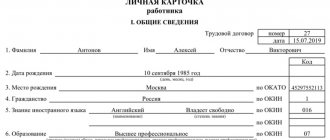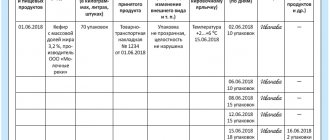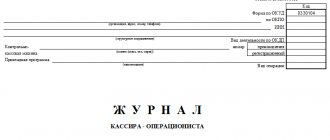What kind of occupational safety magazines are there?
The legislation of the Russian Federation in the field of labor protection (Labor Code of the Russian Federation, GOST 12.0.004-90, Decree of the Ministry of Labor of the Russian Federation dated December 17, 2002 No. 80) requires Russian employers to keep logs:
- registration of introductory briefings on labor protection (clause 7.1.5 GOST 12.0.004-90);
- registration of labor safety briefings that are not introductory (clause 7.9 of GOST 12.0.004-90);
- taking into account instructions on labor protection (clause 5.10 of the appendix to the resolution of the Ministry of Labor of the Russian Federation dated December 17, 2002 No. 80);
- accounting for the issuance of instructions on labor protection (clause 5.10 of the appendix to the resolution of the Ministry of Labor of the Russian Federation dated December 17, 2002 No. 80);
- registration of accidents (Article 230.1 of the Labor Code of the Russian Federation).
These registers are the main journals on labor protection at Russian enterprises.
We will prepare for you a complete list of labor protection documents that an employer must have
Procedure for keeping a TB journal and sample filling
The safety briefing log must be kept continuously at the enterprise in a standard form in compliance with the mandatory details provided for by GOST 12.0.004-90. This document can be supplemented by the company depending on the type of activity performed. As a rule, these magazines can be purchased from printing houses in ready-made form. It is advisable to create a separate register for each type of instruction. The safety log must be laced, numbered, sealed with the company seal and endorsed with the signature of the manager.
During training, the employee is provided with safety instructions, which he studies. The safety officer explains the main points and answers all the employee’s questions. After this, the engineer checks the knowledge gained and enters the relevant data into the safety briefing log.
The title page contains the name of the organization and its structural unit. The following is the name of this register. In the lines “Started” and “Ended” you must write down the corresponding dates.
The tabular part of the document indicates the date of training, full name, year of birth of the person being instructed, his profession or position, and the structural unit where the employee is going to work. Then fill in information about the type of instruction provided, full name. instructing. As soon as the employee becomes familiar with the safety rules, the log is signed by the person responsible for the instruction and the employee himself.
When a mandatory internship is provided, it is necessary to fill out the appropriate columns with the number of shifts, signatures of the intern and the person who conducted it.
In the case of unscheduled training, in the line with the type of training, you must indicate the reasons that caused it.
In addition to this magazine, the organization can use personal training cards, which are compiled for each employee.
Who is responsible for maintaining labor safety logs?
By separate orders of the company management, those responsible for maintaining:
- both types of briefing logs;
- accident register.
The competence of persons appointed by management to be responsible for maintaining these labor safety logs includes:
- timely entry of necessary information into them;
- prompt provision of occupational safety journals for use by other specialists, as well as their subsequent acceptance back for storage.
Regarding log books and issuing instructions, management can also appoint an employee responsible for maintaining and storing them. If the document is developed for a specific structural unit of the company, its storage should be carried out by the head of this unit.
Who is responsible for compiling and maintaining the journal?
The necessary forms, which must be uniform for all divisions of the enterprise, are kept by the health and safety engineer or any other employee who has been entrusted with this responsibility by the relevant order of the organization. The employee of the organization who is responsible for on-the-job training should obtain the log from the HSE engineer. As a rule, such an employee is the workshop manager or site foreman.
All pages are numbered, stitched and certified with the seal and signature of the employee or head of the organization responsible for its maintenance. Basically, most organizations order daily safety training magazines from printing houses.
Specifics of filling out occupational safety logs
Now let’s look at what nuances an employer should pay attention to when filling out occupational safety logs.
For both types of training logs, it is important to pay attention to:
- the presence of signatures of the person being instructed and the person instructing opposite each entry on the instruction;
- indication of the full name and positions of the instructed employee and instructor, the date of each briefing.
To fill out the instruction logbook, the following are of greatest importance:
- correct indication of the date of registration of the instruction and the beginning of its use;
- correct title of documents;
- presence of signatures of the responsible employee confirming the fact of acceptance of the instructions for registration.
With regard to the instruction log, special attention should be paid to:
- correct indication of the date of issue of instructions upon request;
- indication of the full name of the employees receiving instructions, as well as the presence of their signatures.
When filling out the accident log, it is important to indicate:
- the exact date, time, location of the incident;
- all necessary information about the victim;
- measures taken to eliminate the causes of the accident.
These nuances of filling out occupational safety logs are among the most critical. This does not mean that other columns or paragraphs of the document need not be filled out at all. It is also necessary to work with them, but errors or omissions of entries in them may not be as critical as in the elements of occupational safety journals reflected above.
INTRODUCTION REGISTRATION LOG
Logbook for issuing labor safety instructions
JOURNAL OF REGISTRATION OF INSTRUCTIONS AT THE WORKPLACE
JOURNAL of recording instructions on labor protection for workers
JOURNAL of registration of accidents at work
Fire safety briefing log
One of the most important parts of an enterprise’s fire safety policy is training personnel in the rules of behavior to exclude or eliminate fire hazardous situations. Information about the training conducted is recorded in a separate fire safety briefing log.
Briefing log form
The fact of the briefing and the receipt of the necessary information by employees is recorded in a special journal. The form of this document was approved in the annex to the Decree of the State Standard of the USSR (dated November 5, 1990 No. 2797). The resolution itself has long lost force, and the application, with minor changes, is still in use.
The log is a table where the following data is indicated line by line:
- the date of the;
- name of the employee undergoing training;
- the year of his birth;
- profession and position;
- type of instruction;
- reasons for holding (only for unscheduled events);
- instructor's name and position;
- signatures of the employee and instructor.
If the briefing is carried out for a trainee during an internship, 3 additional columns are filled in:
- duration of internship;
- a mark on completion of the internship (put after completion);
- signature of the instructor on testing the trainee’s knowledge.
How to fill out a workplace briefing log? To save time, the instructor enters in advance the names and positions of those being instructed, as well as the type of event (introductory, target, etc.). Then he talks with employees, explains the rules of conduct, answers questions and explains controversial situations. The employees then sign next to their name, thereby confirming that they have received all the necessary information.
Example:
| date | Full name of the instructed employee | Year of birth | Structural unit, position | Type of instruction | Reasons for unscheduled briefing | Instructor | Employee signature | Instructor's signature |
| 27.04.2019 | Virova M.V. | 1989 | Sales department, marketer | Primary | – | Skarev P. R. | Virova | Skarev |
How to fill out a journal correctly
The journal is always filled out by hand. The form can be downloaded in the next section or you can buy a ready-made book at any stationery store. The document should be bound and the pages numbered to protect against forgery. The filling procedure is very simple.
Rules for filling out the workplace briefing log:
- The document is created on paper in one copy.
- It is numbered as you fill it out, and after completion it is stitched and sealed.
- The main part of the data is entered into the log by the instructor. Those being instructed only put their signature; they do not write anything else in this document.
- The actual date of the event is always given. If the briefing was planned for one time, but for some reason took place at another time, indicate the actual date.
- Information is entered in neat, legible handwriting, without corrections or discrepancies.
One magazine is used for all types of briefings.
Why do you need a fire safety training log in the workplace?
Mastering the theoretical part of safety precautions at an enterprise is a prerequisite for admitting a newly arrived employee to his workplace. In addition to introductory training, other types of classes are provided for employees, depending on their length of service at the enterprise or other special conditions. There are a total of 5 types of training for staff:
- - introductory;
- - primary;
- - repeated;
- — target;
- - planned.
It is unacceptable to treat filling out the instruction registration book as a mere formality. Indeed, in the event of an emergency at the enterprise, it will confirm that training sessions were conducted with employees. And any inspection by the fire department will first require a log.
The manager or person responsible for safety is responsible for the timeliness and correctness of filling out the log. The authorized employee must have perfect knowledge of the discipline being taught and have experience working at the enterprise in question. In addition, he is required to have personal qualities that will help ensure a safe environment in the enterprise.
Important! Often, upon arrival to a new position, an employee undergoes simultaneously training in fire safety and labor protection. In such a situation, appropriate entries in separate journals are necessary.
What are they needed for
Health and safety records confirm that the employer complies with current legislation regarding the timeliness and regularity of employee training. Documents prove not only the reality of the training provided, but also its frequency. They allow you to record information about checking the information and practical skills acquired by employees on safe professional activities.
The content and correctness of the design are checked by regulatory authorities.
The presence of such a document confirms the responsibility of the employer towards its employees.
It helps in understanding the need and importance of having the document in question, for example, the publication “Industrial and Environmental Safety, Occupational Safety and Health” - a magazine that is an assistant for an occupational safety specialist.
Fire safety induction log form
To ensure that the responsible employee does not have problems with the inspection authorities, it is important to learn how to fill out the logbook for the introductory fire safety briefing.
Traditionally, each page of such a book contains a table with columns:
- — Date of instruction;
- — Full name of the employee who attended the instruction;
- — year of birth of the person being instructed;
- — the position of the listener;
- — type of instruction;
- — Full name of the instructor;
- — signatures of participants.
- Before you start filling out the log, it is important to make sure that it meets the following requirements:
- Convenient firmware. The sheets must be stitched with thin lace or thread. It is important to make sure that all pages open comfortably and that the text is completely readable.
- Seal. After stitching the book, the ends of the lace are glued to the cover along with a special sticker. It indicates the number of sheets in the magazine, the lacing date and information about the responsible employee. After the glue has dried, a stamp is placed on the sticker and part of the cover.
- Numbering. Page counting can start from the cover or from the first page with a table. For numbering, a pen, a stamp, or a printout can be used. The main thing is that the page numbers are indicated before using the book.
Procedure and rules for filling out
The log of registration of workplace training is kept on the spread of an A4 stationery book. The working field for recording consists of 12 points (graphs) arranged in a line. If necessary, one record can span two or more lines. Then dashes are made in the remaining free points. Often, in order not to bother oneself with unnecessary writing, they are left empty. In this case, the commissions do not find fault, but suddenly, as they say, God forbid, the investigative authorities will have a lot of questions.
Each new year is marked by writing on the entire line with dashes on both sides to the ends of the line, for example: ———— Year 2014 ————. In each subsequent year, numbering begins with number 1. If it is necessary to refer to a document, write: “Record No. of such and such year.”
The order of filling out the columns is as follows:
- Column 1. Serial number.
- Column 2. The date is written in the format dd.mm.yy. More than one journal may be filled out in a year, or the old one will end and a new one will be started, so we write the date in full.
- Column 3. The surname, name, patronymic of the person being instructed is written in full - Ivan Vasilievich Romanov.
- Column 4. The year of birth is written in numbers, possibly with the date: 08/19/1987.
- Column 5. Profession, position of the person being instructed. We write both the profession and the position. For a posted (visiting) employee, we must indicate the main place of work and information from his work ID. If the company from which the business traveler arrived does not issue certificates, we write down the basis on which he arrived at the enterprise and was allowed to work.
- Column 6. Type of briefing: introductory, primary, targeted, repeated, regular (scheduled), extraordinary (unscheduled). We are writing a type of instruction. For targeted instruction, we indicate which regulatory documents were used to instruct: target, instruction No. such and such, or, for example, target according to paragraphs. 2.2.7 PUEP.
- Column 7. The reason for the unscheduled (unscheduled, repeated) briefing is indicated again, on the basis of what. We write: “By order of the head of the workshop” or “By order of the general director No. such and such from such and such a date.”
- Column 8. Last name, initials, position of the instructing (permitting) person. If the instructing person and the permitting person are not the same person (this is permissible only in exceptional cases, for example, during the liquidation of an accident), we write: “Instructed by such and such; admitted such and such on the basis of such and such.”
- Column 9. The signature consists of two subgraphs 9.1 for the instructing and 9.2 for the instructing. The only clarification is that you cannot sign in pencil; the signature must be indelible.
- Columns 10, 11 and 12 are combined into one supergraph: Internship at the workplace. Columns 10 and 11 number of shifts from ____ to ____ and internship completed (worker’s signature) are filled in accordingly if necessary. It is the trainee who signs in column 11. His signature certifies that he is ready to work independently and is fully responsible for himself. The signatures of the person being instructed in columns 9.2 and 11 must match.
- Column 12. Knowledge checked, permission to work issued (signature, date) is filled in by the person admitting him. If there is more than one person instructing and allowing, then the signatures in columns 9.1 and 12 may not match, but this must be justified as described above.
Sometimes column 12 is divided into two: “assessment” and “instructor’s signature.” There is no point in this, because... There are only two assessments: “knows” and “does not know.” If the person being instructed does not know, the person instructing simply will not sign. Boxes 10, 11 and 12 are for internships only. An experienced worker is allowed to work by the instructor’s signature in column 9.1.
If necessary, departmental rules may provide additional columns, for example, to indicate the type of work for targeted instruction and its conditions: lifting height, immersion depth, permissible weather conditions, etc.
Rules for filling out the logbook for fire safety briefings
The legislation establishes strict standards for filling out and maintaining current logs, as well as storing archival documents.
When filling out the pages of the journal, it is prohibited:
Types of safety training
Depending on when it is carried out, as well as the focus of familiarization with work in hazardous conditions, it is divided into the following types:
- introductory, mainly carried out when hiring a new employee or changing the type of activity of an employee;
- target;
- extraordinary;
- repeated, the most common type of instruction;
- introduction of safety rules in the workplace.
When performing an extraordinary inspection, a corresponding entry is made in the journal, which indicates the need for it.
After such familiarization, as in the case of primary and secondary, the instructed employee is required to sign.
With targeted instruction, which is carried out according to the work order, the employee receives permission to perform the necessary work. This type of job introduction includes:
- performing various works of a one-time nature;
- eliminating the consequences of various types of accidents;
- carrying out major events in which most of the organization’s employees are involved;
- in cases where work requires a permit or special permit.
What is the briefing like?
The registration log contains notes on the completion of the following types of instruction:
- Initial or introductory – employees who have just got a job undergo it and become familiar with the specific requirements in force at their immediate workplace. In some cases, an internship is required before marking completion, in others (for example, if the employee is undergoing fire safety training) this is not necessary.
- Subsequently, each employee must undergo repeated training at least once every six months. This is required so that a person does not forget about safety requirements, and when updating the regulations on labor protection, I can receive information about innovations.
- The same fire safety briefing or machine safety briefing can take place outside the plan. This is usually due to the introduction of new equipment or to provide additional security measures after an incident.
Why is it needed?
Cover of the registration log and briefing at the workplace
Safety briefing is necessary in order to prevent emergency incidents that may occur to workers when performing their job duties without complying with certain requirements. The regulation of these requirements is directly related to the production process in the organization, the equipment and raw materials used, and the severity of harmful factors in working conditions.
Employees undergo initial briefing upon entry to work; repeated instructions can be carried out both planned and unscheduled, for example, upon the arrival of new equipment used in production cycles. Repeated training of personnel is carried out once every six months to update and update information. If necessary, these events can be held more often. There are situations in which there is a need for targeted instruction, which is recorded in the workplace instruction log. Such situations include:
- Organizational actions for holding mass events;
- One-time, one-time work;
- Activities requiring separate permits and admissions;
- With the participation of workers in eliminating the consequences of natural and man-made disasters.
Data on the instructions carried out can be entered both in the general logbook of registration of instructions at the workplace, and in a separate document intended for certain types of instructions.
Important! Initial training must be carried out with all persons involved in production activities, including temporary workers and persons working at home using equipment, machinery or raw materials provided by the employer.
Workplace briefing logbook form
What does the concept of “introductory briefing” mean?
This term hides the familiarization of newly hired employees of the enterprise with the norms and rules of labor protection adopted in the organization. In this case, the position, education, work experience and other characteristics of the employee do not matter - everyone must go through this procedure, from representatives of the management team to general workers. Moreover, in many companies, induction training is supposed to be carried out with business travelers, as well as persons undergoing training. Lack of information about the completion of training is a sufficient basis for preventing an employee from performing labor functions.
Introductory briefing is formed on the basis of standards drawn from the legislation of the Russian Federation and the specifics of the enterprise. It includes data regarding the direction of the company’s work, clauses of the Labor Safety Regulations and Internal Labor Regulations common to all employees, information about harmful and dangerous factors occurring in the organization, personal protective equipment and methods, standards of conduct, etc. .d. The employee is also familiarized with the procedure for providing first aid and the procedure for action in the event of emergency and fire situations.
To conduct water training, a separate room is usually used, which contains theoretical publications, visual aids, auxiliary technical means and other devices necessary to create a complete picture of labor protection at the enterprise.
How to keep a journal
The issuance of labor safety instructions is carried out by a separate personnel employee - an occupational safety specialist (engineer). He can familiarize workers with the rules of safe work activity both orally and in writing. He will also have to draw up and maintain a log of safety briefings at the workplace.
The format of the magazine is unified, so there is no need to think long about its preparation. A sample document is presented in the appendix of the new GOST (12.0.004-2015). It is recommended to divide the table into 12 columns:
- Date of instruction.
- Full name of the employee being trained.
- The year of his birth.
- Position in the organization, profession.
- Type of training provided.
- The basis for the unscheduled training session (if there was one).
- Position and full name of the person conducting the instruction.
- Signatures of the occupational safety instructor and employee (for each - a separate column).
Another 3 columns are devoted to internships organized for work. place. Indicated:
- number of shifts;
- signature of the employee certifying that the internship was completed;
- confirmation from the instructor that the employee is allowed to work.
There should be no empty spaces in the columns. If any of the columns is not filled in, you need to put a dash. Entries in the table are made by hand. The magazine must be stitched. The ends of the used cord and the resulting knot are sealed to the back of the document.
Before stitching the magazine, its pages are numbered, starting with the title page. It must contain the following details:
- name of the employing organization;
- name of the structural unit;
- document's name;
- start and end dates of document maintenance.
When the journal is completely filled, it is handed over to the responsible person for storage. The document is stored for 10 years.
The legislative framework
The main legislative acts that regulate that an employer must have a logbook on occupational safety and health are:
- Resolution of the Ministry of Labor of the Russian Federation and the Ministry of Education No. 1/29 of January 13, 2003 (as amended on November 30, 2016), which approves the “Procedure for training in labor protection and testing knowledge of labor protection requirements for employees of the organization” (hereinafter referred to as the Procedure for training).
- GOST 12.0.004-2015 System of occupational safety standards (OSSS). Organization of occupational safety training. General provisions (hereinafter GOST 12.0.004-2015).
In paragraph 2.1.3. The training procedure states that the fact of completing all types of labor safety briefings must be recorded in special journals.
There are five types of instruction in total:
- introductory;
- primary;
- repeated;
- target;
- unscheduled.
The forms by which occupational health and safety logs are kept are established by GOST 12.0.004-2015.
This document came into force only on March 1, 2017. He is the “successor” of the old GOST 12.0.004-90. The introductory provisions of the new GOST say that it retains the basic rules that were in the document from 1990. But at the same time, some changes appeared. Previously, registration of briefings was carried out in two journals:
- Safety log for induction training.
- Journal for all other (four) types of briefings.
In the new GOST, a separate register has been allocated for targeted instruction.
Who performs the procedure
Typically, the briefing is carried out by a separate employee of the company: a labor protection engineer or inspector, the head of the human resources department (i.e., the one who has this function written into his job responsibilities or the one who is appointed by a separate order from the director of the organization).
At manufacturing enterprises, a specially trained employee may be responsible for certain parts of the instruction.
To fulfill his duties, the instructor must act in full accordance with the program, which is developed at the stage of creating the company and approved by management. After the employee has been instructed, he is required to sign this in a special journal.









